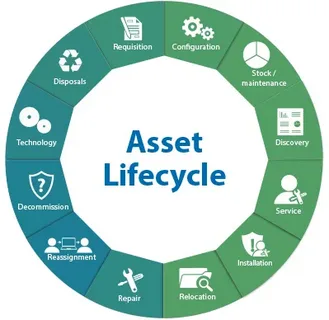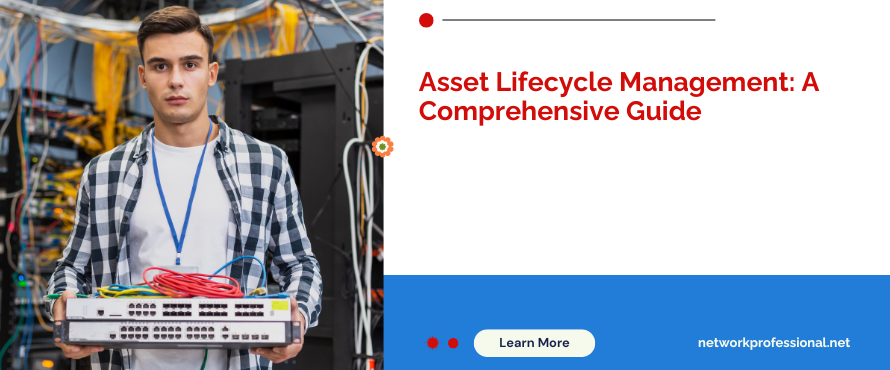After acquiring assets, the next phase in Asset Lifecycle Management (ALM) for network and IT services is deployment and commissioning. This involves installing the IT equipment, configuring network systems, testing them to ensure they meet performance standards, and training staff to effectively use the new technology. Proper commissioning is crucial to ensure that assets are fully operational, reducing the likelihood of early system failures. In cities like Manchester and Worcester, efficient deployment supports business continuity and maximizes the value of IT investments.
Introduction to Asset Lifecycle Management (ALM)
Definition and Importance of ALM
In today’s competitive environment, effective ALM can be a differentiator for businesses. It enables organizations to extend the life of their assets, reduce unexpected failures, and ensure compliance with regulations. Whether it’s physical assets like machinery and equipment or digital assets such as software, ALM is vital for maintaining their performance and value over time.

Key Components of ALM
ALM involves several components that work together to manage the entire lifecycle of an asset:
- Planning and Acquisition: This involves assessing the need for new assets, selecting the right ones, and planning for their acquisition.
- Deployment and Commissioning: This stage includes installing and commissioning the asset, ensuring it meets operational requirements.
- Operation and Maintenance: Regular monitoring and maintenance are crucial to keep assets in optimal condition and prevent breakdowns.
- Decommissioning and Disposal: Finally, assets must be safely decommissioned and disposed of when they reach the end of their useful life.
Industries That Rely on ALM
Stages of the Asset Lifecycle
Planning and Acquisition
Deployment and Commissioning
Operation and Maintenance
Asset Performance Management
Asset Performance Management (APM) is an advanced aspect of ALM that involves using data analytics, IoT, and AI to monitor and optimize asset performance. APM helps in predicting failures before they occur, optimizing maintenance schedules, and improving overall asset reliability.
Decommissioning and Disposal
The final stage of the asset lifecycle is decommissioning and disposal. When assets reach the end of their useful life, they must be safely decommissioned and disposed of in a manner that complies with environmental regulations. This stage also involves evaluating the residual value of the assets and deciding whether to sell, recycle, or dispose of them.
Benefits of Effective Asset Lifecycle Management
Cost Efficiency and Budget Management
One of the most significant benefits of ALM is cost efficiency. By managing assets effectively throughout their lifecycle, organizations can avoid unnecessary expenditures, reduce downtime, and optimize maintenance costs. Proper ALM also aids in budgeting, as it provides a clear understanding of the total cost of ownership and helps in planning future investments.
Enhancing Asset Performance and Reliability
Risk Mitigation and Compliance
Effective ALM helps organizations mitigate risks associated with asset failures, safety issues, and regulatory non-compliance. By ensuring that assets are well-maintained and meet all regulatory standards, organizations can avoid costly penalties and reputational damage.
Sustainability and Environmental Impact
ALM contributes to sustainability by promoting the efficient use of resources and reducing waste. By extending the life of assets and ensuring their proper disposal, organizations can minimize their environmental impact and contribute to sustainable practices.
Challenges in Asset Lifecycle Management
Data Management and Integration
One of the primary challenges in ALM is managing and integrating data from various sources. With the advent of IoT and other technologies, organizations collect vast amounts of data on asset performance. However, integrating this data into a cohesive system that provides actionable insights can be challenging.
Aging Infrastructure
Many industries, particularly in the energy and transportation sectors, deal with aging infrastructure that requires constant maintenance and upgrades. Managing these assets effectively while balancing costs and operational needs is a significant challenge.
Regulatory Compliance
Compliance with various regulations, such as environmental laws and safety standards, is a critical aspect of ALM. Staying up-to-date with changing regulations and ensuring that all assets comply can be a daunting task for organizations.
Technological Complexity
The increasing complexity of modern assets, particularly in industries like IT and healthcare, poses challenges for ALM. Managing these assets requires specialized knowledge and advanced tools to monitor, maintain, and optimize their performance.
Best Practices for Asset Lifecycle Management
Implementing ALM Software Solutions
Utilizing specialized ALM software can significantly enhance the efficiency of asset management. These solutions provide tools for monitoring asset performance, scheduling maintenance, and managing the entire asset lifecycle from a centralized platform.
Developing a Comprehensive ALM Strategy
A well-defined ALM strategy is essential for successful asset management. This strategy should include clear objectives, processes for each stage of the asset lifecycle, and performance metrics to evaluate the effectiveness of the ALM program.
Training and Workforce Development
Proper training and development of the workforce are crucial for the effective implementation of ALM. Employees should be trained on the use of ALM tools, maintenance procedures, and safety standards to ensure that assets are managed effectively.
Continuous Improvement and Innovation
ALM is not a static process; it requires continuous improvement and innovation. Organizations should regularly review and update their ALM practices to incorporate new technologies, optimize processes, and improve asset performance.
The Role of Technology in ALM
Internet of Things (IoT) in ALM
The Internet of Things (IoT) has revolutionized ALM by enabling real-time monitoring of assets. IoT devices can collect data on asset performance, environmental conditions, and usage patterns, providing valuable insights that help in optimizing maintenance schedules and improving asset reliability.
Predictive Maintenance and AI
Predictive maintenance, powered by artificial intelligence (AI), is a game-changer for ALM. By analyzing data from IoT devices and other sources, AI can predict when an asset is likely to fail, allowing organizations to perform maintenance before a breakdown occurs. This approach reduces downtime, extends asset life, and lowers maintenance costs.
Digital Twins and Simulation
Digital twins, which are virtual replicas of physical assets, allow organizations to simulate different scenarios and predict how assets will perform under various conditions. This technology is particularly useful for testing maintenance strategies and optimizing asset performance without disrupting operations.
Data Analytics and Asset Performance
Data analytics plays a critical role in ALM by transforming raw data into actionable insights. By analyzing trends, patterns, and anomalies in asset data, organizations can make informed decisions about maintenance, upgrades, and replacements, ultimately improving asset performance and reliability.
Case Studies: Successful Implementation of ALM
Case Study 1: ALM in Manufacturing
In the manufacturing sector, effective ALM has been shown to reduce downtime and improve production efficiency. For example, a major automotive manufacturer implemented a comprehensive ALM strategy that included predictive maintenance and IoT monitoring, resulting in a 20% reduction in equipment downtime and significant cost savings.
Case Study 2: ALM in the Energy Sector
The energy sector, particularly in power generation and distribution, relies heavily on ALM to maintain infrastructure and ensure reliable service. A leading energy company implemented a digital twin-based ALM solution, which allowed them to optimize maintenance schedules and reduce the risk of outages, leading to improved service reliability and customer satisfaction.
Case Study 3: ALM in Healthcare
In the healthcare industry, where equipment uptime can be a matter of life and death, ALM is critical. A large hospital network adopted an ALM system that integrated IoT and AI for real-time monitoring of medical equipment. This approach reduced equipment downtime by 30%, improved patient outcomes, and ensured compliance with healthcare regulations.
Future Trends in Asset Lifecycle Management
AI and Machine Learning in ALM
Artificial Intelligence (AI) and Machine Learning (ML) are set to play an increasingly important role in ALM. These technologies will enable more sophisticated predictive maintenance, automate decision-making processes, and provide deeper insights into asset performance.
Cloud-Based ALM Solutions
Cloud-based ALM solutions offer greater flexibility, scalability, and accessibility compared to traditional on-premises systems. As organizations continue to adopt cloud technologies, ALM solutions will become more integrated, allowing for seamless data sharing and collaboration across different locations.
Sustainable Asset Management Practices
Sustainability is becoming a key consideration in ALM. Organizations are increasingly focusing on reducing the environmental impact of their assets through practices such as energy-efficient operation, recycling, and the use of sustainable materials. Future ALM strategies will likely place even greater emphasis on sustainability.
Integration of Blockchain Technology
Blockchain technology has the potential to revolutionize ALM by providing secure, transparent, and immutable records of asset transactions and maintenance histories. This could improve compliance, reduce fraud, and enhance the traceability of assets throughout their lifecycle.
How to Choose the Right ALM Solution for Your Business
Assessing Your Business Needs
The first step in choosing the right ALM solution is assessing your business needs. Consider the types of assets you manage, the complexity of your operations, and your budget. Understanding your specific requirements will help you select a solution that aligns with your goals.
Key Features to Look For in ALM Software
When evaluating ALM software, look for key features such as real-time monitoring, predictive maintenance capabilities, data analytics, and integration with other business systems. A user-friendly interface and robust reporting tools are also essential for effective asset management.
Vendor Selection and Evaluation
Choosing the right vendor is critical to the success of your ALM implementation. Evaluate vendors based on their industry experience, customer support, and the scalability of their solutions. Consider conducting a pilot program to test the software’s performance before making a final decision.
Cost-Benefit Analysis
Conducting a cost-benefit analysis is essential to ensure that the ALM solution you choose provides a good return on investment. Consider not only the upfront costs but also the long-term benefits such as reduced maintenance costs, improved asset performance, and extended asset life.
FAQs on Asset Lifecycle Management
What is the main goal of Asset Lifecycle Management?
The main goal of Asset Lifecycle Management is to maximize the value of assets throughout their lifecycle while minimizing costs and risks. This involves effectively managing assets from acquisition to disposal, ensuring optimal performance, reliability, and compliance.
How does ALM software improve asset management?
ALM software improves asset management by providing tools for real-time monitoring, predictive maintenance, data analytics, and centralized management of all asset-related activities. This helps organizations make informed decisions, reduce downtime, and extend the life of their assets.
What industries benefit most from ALM?
Industries such as manufacturing, energy, transportation, healthcare, and IT benefit significantly from ALM due to their reliance on complex, high-value assets that require regular maintenance and optimization to ensure peak performance and compliance.
What challenges might a company face when implementing ALM?
Challenges in implementing ALM include managing and integrating large volumes of data, dealing with aging infrastructure, ensuring regulatory compliance, and handling the complexity of modern assets. Overcoming these challenges requires a well-defined strategy, the right tools, and trained personnel.
How does ALM contribute to sustainability?
ALM contributes to sustainability by promoting efficient use of resources, extending the life of assets, and ensuring proper disposal or recycling of assets at the end of their lifecycle. This helps organizations reduce waste, lower their environmental impact, and adopt more sustainable practices.
What are the future trends in Asset Lifecycle Management?
Future trends in ALM include the increased use of AI and machine learning for predictive maintenance, the adoption of cloud-based ALM solutions, a greater focus on sustainable asset management practices, and the integration of blockchain technology for secure and transparent asset management.
Conclusion
Recap of Key Points
Asset Lifecycle Management is a comprehensive approach to managing assets throughout their entire lifecycle, from acquisition to disposal. It plays a crucial role in maximizing asset value, reducing costs, and ensuring compliance with regulations.
The Future of Asset Lifecycle Management
Final Thoughts
Implementing a robust ALM strategy is essential for organizations that rely on high-value assets. By following best practices and leveraging the latest technologies, businesses can optimize their asset performance, extend their lifespan, and achieve significant cost savings. The key to success lies in continuous improvement and staying ahead of industry trends.


Leave A Comment